No one wants to admit it, but the truth is that September and October are transition months for fishing down here in Miami, FL. Some days, it feels like there’s just no fish in the ocean. While the fishing in Miami, FL is great year round compared to almost everywhere else in the U.S, September and October are typically the slowest months for offshore fishing due to a myriad of environmental factors beyond our control. In order to keep the rods bent this fall while you wait in anticipation of the upcoming sailfish season, try these four fall fishing tips!
While the fishing in Miami, FL is great year round compared to almost everywhere else in the U.S, September and October are typically the slowest months for offshore fishing due to a myriad of environmental factors beyond our control. In order to keep the rods bent this fall while you wait in anticipation of the upcoming sailfish season, try these four fall fishing tips!
Push Farther Offshore
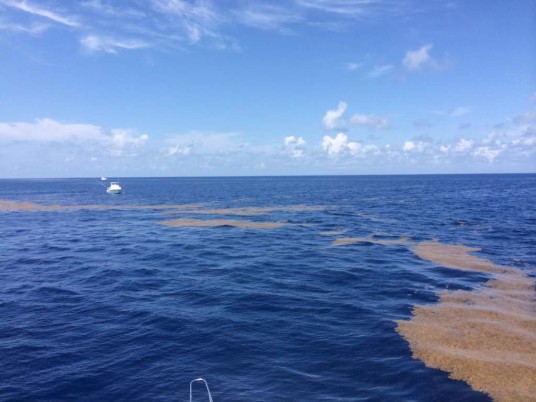 While the fall is not considered the hottest time of the year for targeting mahi-mahi, there are still good numbers of schoolies offshore. These keeper “schoolie” sized mahi’s make for excellent table fare and if you put in the time to locate them, you can still catch upwards of 20 in a day. The trick is to make your way farther offshore than you would during the spring and early summer months. As the weather heats up, these fish tend to move out deeper and search for bait under grass lines. It’s also common this time of year to see large flocks of frigates and birds chasing schools of jacks; typically mahi-mahi will follow the schools in tandem with skipjack and blackfins.
While the fall is not considered the hottest time of the year for targeting mahi-mahi, there are still good numbers of schoolies offshore. These keeper “schoolie” sized mahi’s make for excellent table fare and if you put in the time to locate them, you can still catch upwards of 20 in a day. The trick is to make your way farther offshore than you would during the spring and early summer months. As the weather heats up, these fish tend to move out deeper and search for bait under grass lines. It’s also common this time of year to see large flocks of frigates and birds chasing schools of jacks; typically mahi-mahi will follow the schools in tandem with skipjack and blackfins. The best bet is to cruise offshore slowly – not trolling – looking for birds or debris. We typically ride out to 1200 ft and stop along the way if we find birds or grass – then begin trolling to locate fish. Some of the most common places to find fish in the fall months includes the “double zeros” and anywhere between the 55 and 57 line. Those numbers refer to coordinates on your GPS – put in a bit of research and you’ll get the hang of the locations most charter boats start their hunt for schoolies. It’s rare that you would need to push out deeper than 2000ft while looking for mahi in the fall months – concentrate your efforts between 1000ft and 1600ft and you’ll likely find a few fish. It’s crucial to find grass, birds, or floatsam – trolling aimlessly in deep water may produce a bite occasionally, but you’ll enjoy catching more fish if you have a gameplan.
The best bet is to cruise offshore slowly – not trolling – looking for birds or debris. We typically ride out to 1200 ft and stop along the way if we find birds or grass – then begin trolling to locate fish. Some of the most common places to find fish in the fall months includes the “double zeros” and anywhere between the 55 and 57 line. Those numbers refer to coordinates on your GPS – put in a bit of research and you’ll get the hang of the locations most charter boats start their hunt for schoolies. It’s rare that you would need to push out deeper than 2000ft while looking for mahi in the fall months – concentrate your efforts between 1000ft and 1600ft and you’ll likely find a few fish. It’s crucial to find grass, birds, or floatsam – trolling aimlessly in deep water may produce a bite occasionally, but you’ll enjoy catching more fish if you have a gameplan.
Don’t neglect the deep drop
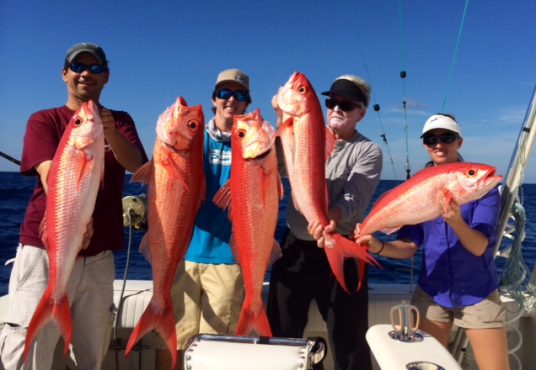
This can be a day saver more often than not. Vermilion snapper, queen snapper, tilefish, and various deepwater species can be found off the coast of Miami, FL in depths from 300ft to 700 ft. The key is to find the right bottom where your target deep water species resides. Vermillion snappers typically live in depths of 250 to 500 ft, but seldom deeper. Tilefish typically live in depths of 500 to 700 ft, but usually on soft bottom. Learn as much as you can about each species before you target them – there’s plenty of general knowledge out there which will give you a head start in working the appropriate areas for each fish. While deep dropping may not be the most glorious kind of fishing we get to enjoy in Miami, FL – when the edge is not producing and the dolphin start to disappear offshore, deep water fish can provide steady action.
Mind the mid-waters
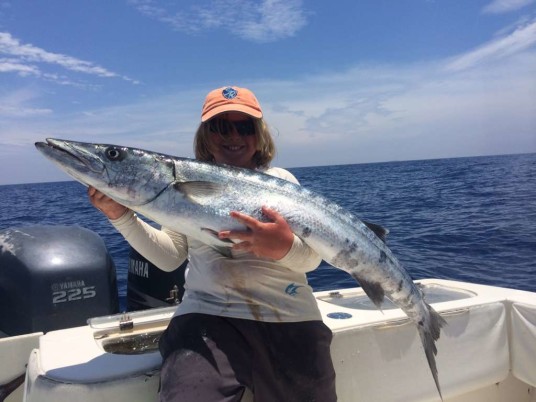 Flat lining and mid-water live baiting can produce a steady bite if current around the edge is consistent. A mix of bonitas, barracudas, and kingfish tend to dominate the water column between 100′ and 150′ during September and October – while not glorious fishing by any means, they can provide steady action. The trick is to fish the entire water column without tangling your live baits – this is typically best accomplished by drifting broad side while using a series of progressive weights (1.5oz, 2oz, 3oz) to suspend baits at various depths. We typically put out out a bottom rod, followed by baits at ~ 70ft, 50ft, and 30ft with a flat line on the surface. Once we start getting bites at a specific depth – we’ll adjust our baits to that range and work it thoroughly. This technique works particularly well when fishing in the vicinity of the country wrecks – anywhere from Key Biscayne north to the Boil.
Flat lining and mid-water live baiting can produce a steady bite if current around the edge is consistent. A mix of bonitas, barracudas, and kingfish tend to dominate the water column between 100′ and 150′ during September and October – while not glorious fishing by any means, they can provide steady action. The trick is to fish the entire water column without tangling your live baits – this is typically best accomplished by drifting broad side while using a series of progressive weights (1.5oz, 2oz, 3oz) to suspend baits at various depths. We typically put out out a bottom rod, followed by baits at ~ 70ft, 50ft, and 30ft with a flat line on the surface. Once we start getting bites at a specific depth – we’ll adjust our baits to that range and work it thoroughly. This technique works particularly well when fishing in the vicinity of the country wrecks – anywhere from Key Biscayne north to the Boil.
Raid the Reefs
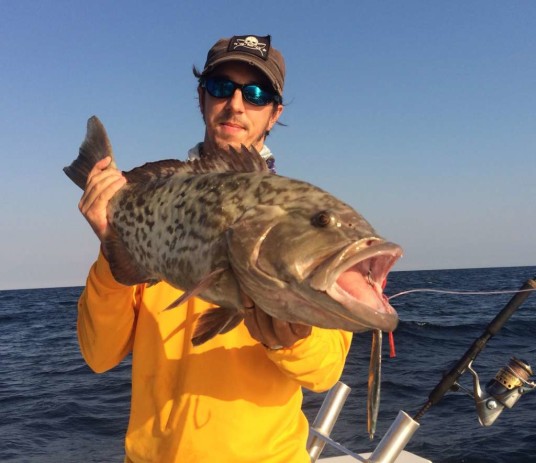 We tend to get caught up in offshore fishing because you never know what you might catch when fishing deep water. In the fall months, when the offshore bite really slows down, the reefs from Fowey Rocks south to Key Largo tend to be very productive. Fishing deep water reefs in the range of 80′ to 110′ can produce mutton snappers, yellowtails, gag or black groupers, and the the occasional amberjack. The key is to find good current and bottom structure with substantial relief. The more rocky and jagged the bottom, the better. Spend the time slow trolling over reef lines until you locate structure that is very pronounced – then anchor up into the current and start fishing. Move around regularly to try different areas unless you’ve found some terrain which really seems to hold alot of life. Keep a chum slick going at the surface while working the bottom with knocker rigs and finder rigs. Use a mix of live bait, cut bait, and even jigs to see what’s in the area. Between September and early November, the bite tends to get pretty good off the ragged keys all the way down to Ceasar’s creek – put in the time to find solid reef structure and you’ll reap the rewards.
We tend to get caught up in offshore fishing because you never know what you might catch when fishing deep water. In the fall months, when the offshore bite really slows down, the reefs from Fowey Rocks south to Key Largo tend to be very productive. Fishing deep water reefs in the range of 80′ to 110′ can produce mutton snappers, yellowtails, gag or black groupers, and the the occasional amberjack. The key is to find good current and bottom structure with substantial relief. The more rocky and jagged the bottom, the better. Spend the time slow trolling over reef lines until you locate structure that is very pronounced – then anchor up into the current and start fishing. Move around regularly to try different areas unless you’ve found some terrain which really seems to hold alot of life. Keep a chum slick going at the surface while working the bottom with knocker rigs and finder rigs. Use a mix of live bait, cut bait, and even jigs to see what’s in the area. Between September and early November, the bite tends to get pretty good off the ragged keys all the way down to Ceasar’s creek – put in the time to find solid reef structure and you’ll reap the rewards.
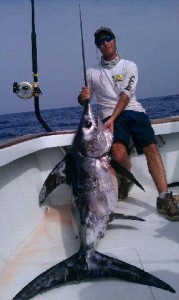
Capt. Charlie Ellis

Latest posts by Capt. Charlie Ellis (see all)
- Curious how to catch or buy live bait in Miami, Florida? Here’s what you need to know! - October 28, 2016
- A Legacy of Venice Louisiana Tuna Fishing - April 7, 2015
- Four Miami, FL Fall Fishing Tips - September 2, 2014
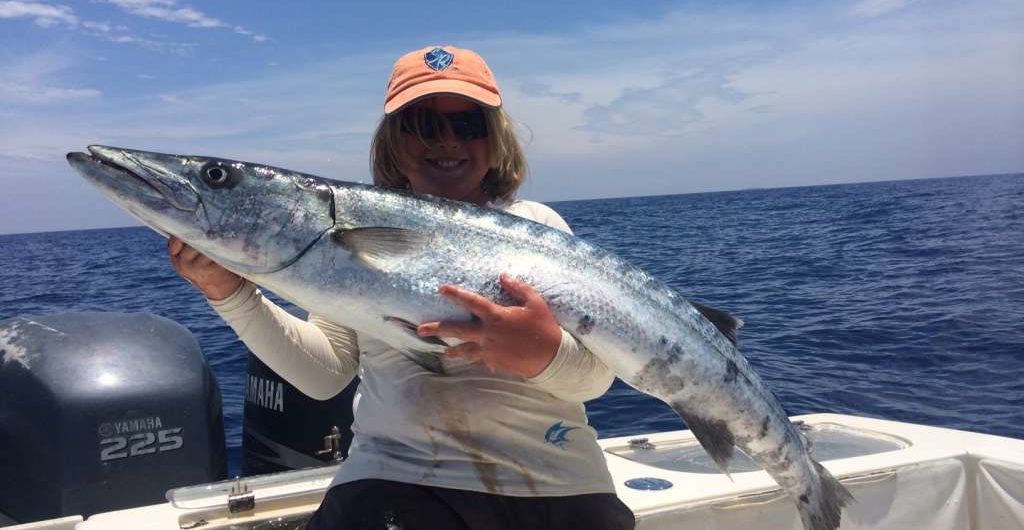
Comments